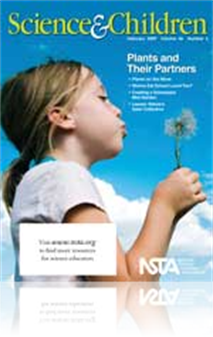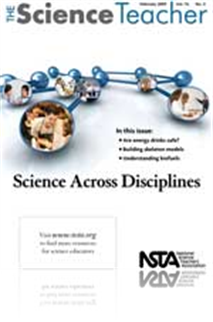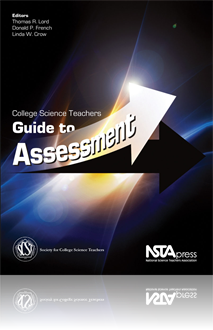All Resources
Journal Article
When it comes to directly interacting with and doing experiments with organisms, plants have some distinct advantages over animals. Their diversity and accessibility allows students to use them in experiments, thus practicing important science inquir...
Journal Article
Science Shorts: Hypothesis Testing—It’s Okay to Be Wrong
Students often seek affirmation from their teachers about their thinking and can be embarrassed at the thought of being “wrong.” In science, we want children to feel comfortable making hypotheses and to know that it’s the investigative process�...
Journal Article
Science Sampler: Using seashells to teach classification
Everyone loves the beach. Unfortunately, most schools don’t have access to beachfront property. So, why not bring the beach to the classroom? This seashell lab investigation is great because students enjoy it, they learn that science is a way to so...
Journal Article
From Cookbook to Experimental Design
Developing expertise, whether from cook to chef or from student to scientist, occurs over time and requires encouragement, guidance, and support. One key goal of an elementary science program should be to move students toward expertise in their abili...
Journal Article
Editor’s Corner: Renaissance Thinking
Although it may be an old-school habit of mind with roots in the Renaissance, interdisciplinary thinking has never been more important than in the modern world. In their daily lives, our students will need to understand complex problems and evaluate ...
Journal Article
Biological Clocks and Circadian Rhythms
The study of biological clocks and circadian rhythms is an excellent way to address the inquiry strand in the National Science Education Standards (NSES) (NRC 1996). Students can study these everyday phenomena by designing experiments, gathering and ...
Journal Article
The Potential da Vinci in All of Us
The study of the human form is fundamental to both science and art curricula. For vertebrates, perhaps no feature is more important than the skeleton to determine observable form and function. As Leonard da Vinci’s famous Proportions of the Human F...
Journal Article
Tried and True: Chipping away at the rock cycle
The National Science Education Standards recommend that middle school students have a clear understanding of the history, composition, and formative processes that shape the Earth. To accomplish this goal, the authors use an engaging activity that us...
Journal Article
Why not combine the use of technology with the excitement of a scavenger hunt that moves middle-level students out into the “wilds” of their school campus to classify plants? In the lesson plan described here, students embark on a botanical scav...
Book Chapter
Building a Culture of Faculty-Owned Assessment
With so much at stake for both students and institutions, it is imperative that colleges and universities support faculty and others in comprehensive assessment efforts and act on changes suggested by assessment data. If higher education is to mainta...
Book Chapter
At Montana State University (MSU) a variety of strategies have been used to begin to quantitatively assess how students are learning in the science classroom. The author reviews in this chapter some of the work that has helped MSU craft quantitative ...
Book Chapter
Alternative Forms of Assessment for The College Science Laboratory
A basic definition of alternative assessment is any type of evaluation that does not use traditional forms of paper-and-pencil testing. Too often new forms of teaching and learning are coupled with traditional forms of student assessment rather than ...
Book Chapter
Survey Instrument Validation: The First Commandment of Educational Research
Survey instrument validation may be the most difficult task for a scientist starting to conduct educational research. A survey that is preceived to be inadequately validated will generally be rejected for publication, but there is little guidance on ...
Book Chapter
The past two decades have witnessed a dramatic shift in how science is taught. Electronic portfolios—hereafter referred to as e-portfolios—represent one possible way to bring assessment into alignment with technology-based instruction. In this ch...
Book Chapter
The integration of math, science, and technology (MST) into robust inquiry-based learning opportunities is a tall order for any educator. However, it is critical to do so throughout the learning process. This chapter addresses some of the deficiencie...
Book Chapter
Gauging the Nature of Science (NOS): An Alternate Form of Assessment
Science teachers of all disciplines can use students' NOS (nature of science) scores as an alternate form of assessment. In addition to traditional forms of assessment like exams and quizzes, NOS levels can truly indicate students' understanding of s...
Book Chapter
In recent years, the value of using authentic assessments to evaluate student learning has been discussed at all levels. The use of authentic assessments, in the use of lesson plans, has proven to be a valuable tool for the evaluation of content mast...
Book Chapter
Formative Assessment With Student Remotes and E-mail
This chapter features two formative assessment techniques that were implemented in several sections of the first semester of an introductory physics class at East Stroudsburg University. The performance of these students was compared to sections in w...
Book Chapter
Peer Assessment: Value, Fears, Headaches, and Success
The idea of peer assessment sounds fantastic and literature shows that it is invaluable. Yet, when most faculty first try peer assessment they are faced with a different reality. This chapter focuses on the obstacles of peer assessment with the first...
Book Chapter
Working With Student Engagement
"Classroom assessment informs teachers how effectively they are teaching and students how effectively they are learning" (Cross 1996). For this purpose, in this chapter the author constructed an assessment tool known as the Diagnostic Learning Log (D...
Book Chapter
Promoting Student Reflection on Exams
One of the greatest challenges in assessing student performance is providing students with the detailed and appropriate feedback they need to learn from their mistakes. Summative assessments, in the form of exams, are used to determine what students ...
Book Chapter
Hypothesis Modification Activity
Many upper-level undergraduate science courses are content and data laden, leaving little room for students to practice important skills such as generating hypothesis and designing experiments. This chapter introduces The Hypothesis Modification Acti...
Book Chapter
Exam Corrections and Analysis, Student Perspective
One of the most difficult parts of being a teacher is giving exams back to students when you know, and students know, that they did not perform well. Students also perceive instructors as being tricky or unfair on exams. To help combat this perceptio...
Book Chapter
Exam Analysis, Instructor Perspective
In this chapter, the author addresses what she thinks is the most difficult job of an instructor—effectively assessing what students have learned. Most instructors can articulate what they want students to know at the end of a unit or class, but de...
Book Chapter
Inquiry-Based Labs: The Scientific Report
In this chapter, the author teaches a General Biology I course with five inquiry-based laboratories. Although it is an introductory biology course for both majors and nonmajors, students are very engaged in the scientific process. A Scientific Report...
Book Chapter
In every science course the author teaches, students choose and read a book available in the campus library and submit a review at the end of the course. The student's review outlines the appropriateness of this book for someone taking the course in ...
Book Chapter
In the author's Biology 350 (genetics) course, the students assemble and demonstrate models to teach concepts related to course content topics. Each student chooses one article from a selection of published papers that describes teaching models for d...
Book Chapter
Eleven Assessment Lessons Learned at the Gate
As a "gateway" instructor for more than 30 years, the author learned a few things about assessing the "typical" community college student. "Gateway" is the polite euphemism for suggesting you will always be teaching the nonscience majors with the hop...
Book Chapter
Developing Assessment Performance Indicators
The goal of assessment is to judge how well a student has learned. This information has a range of uses but is mainly used to improve student learning or for the accreditation of student performance. This chapter is the first attempt to develop a val...
Book Chapter
Practices That Jeopardize Bona Fide Student Assessment
Student assessment is the means by which teachers—the directors of the learning experience—appraise the success of their lessons on students—the product of the instruction. Teachers at every level of instruction realize the importance of fair, ...
Book Chapter
Varied Assessment: A Brief Introduction
Although often seen as a means for evaluation, assessment is first and foremost an instructional tool. Use of multiple assessment strategies can provide students with diverse feedback, allowing them to view the subject and their understanding of it f...
Book Chapter
Assessments That Assist in Motivating Students
Assessments are one of the few ways students can be reached individually. You can directly interact with each student. If used in thoughtful ways, assessments can motivate students to engage in class and to study on their own. In this chapter, the au...
Book Chapter
Means of Linking Research to Practice in Organizing a Course on Student Assessment
Accurate assessment of student achievement is an important requirement of educators. The author, in his role as professor in Science Education at the University of Calgary, taught an assessment course for master's students and student teachers. The ...
Book Chapter
Writing/Using Multiple-Choice Questions to Assess Higher-Order Thinking
Most graduate entrance exams (including the GRE, MCAT, and DAT) are based on multiple-choice questions. Many later exams, such as the medical board exams, are also multiple choice. Therefore, it is important to make sure that students are prepared fo...






